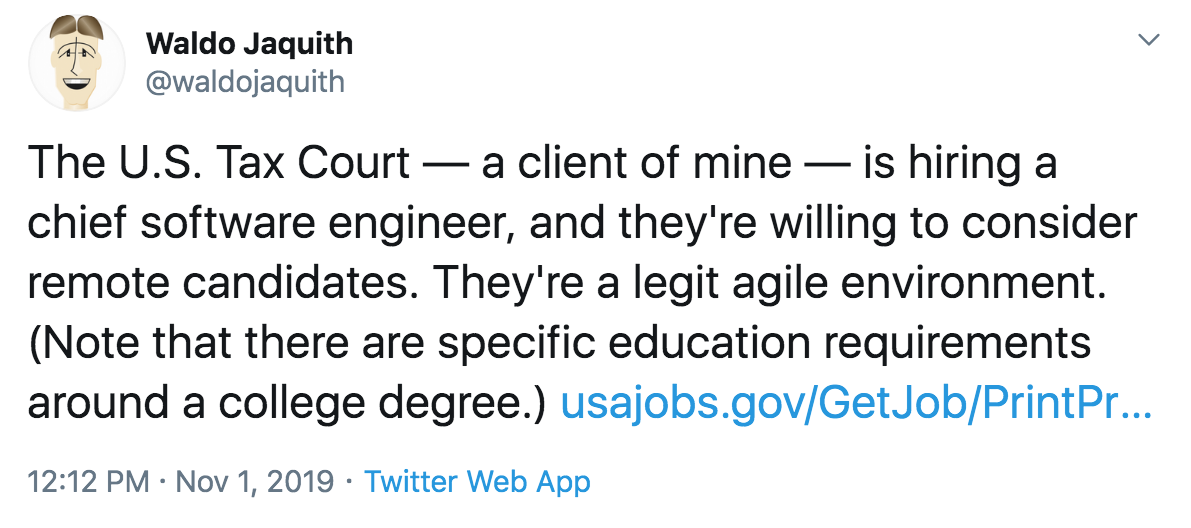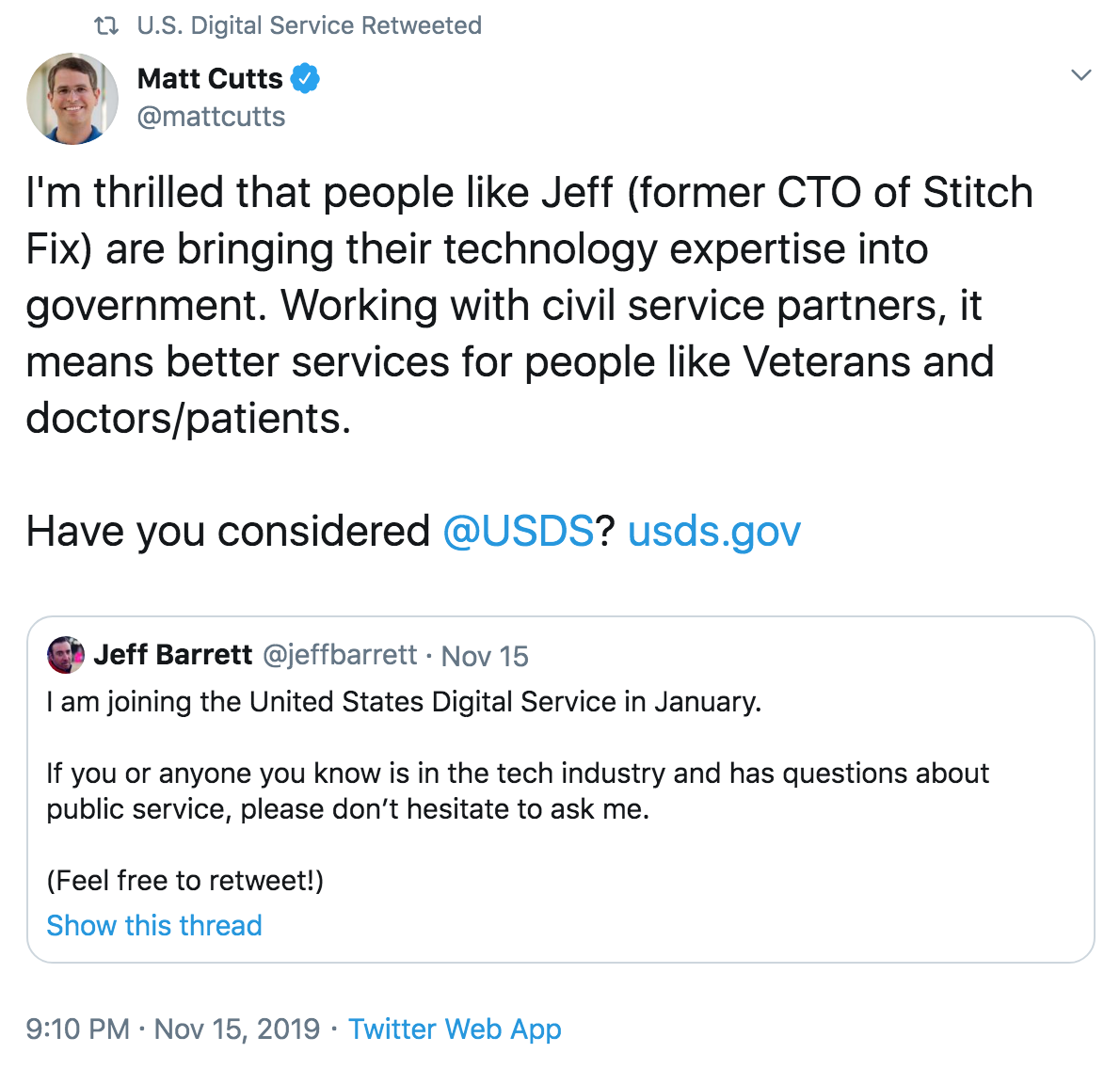Building a movement and a presence
Share your team’s mission and work by building a brand and a presence — both online and in-person — as part of your communications efforts.
Building this presence will help you:
- Communicate with and engage key stakeholders in your mission and vision
- Share successes and lessons learned, capturing the work you’ve done and its impact
- Drive team culture by sharing how you work
- Attract potential employees and help grow supporters and audiences to engage further
Define and understand your audience
Define your target audiences with an understanding of what you’d like to communicate to them and what they’d like to get from you. Since resources and capacity are rarely unlimited, it’s best to identify two to three primary audiences to focus on in your communications and engagement efforts.
Your target audience may vary over time. For example, as you stand up your team, you might focus on attracting new recruits. As your team matures, your target audiences could expand to include the public, government leaders and legislators, and other, similar digital teams. Identifying and understanding your audience and objectives from the start will also allow you to evaluate the impact of your communication activities later on and adjust them accordingly.
Build and maintain an online presence
You’ll first want to figure out your team’s capacity for establishing and maintaining communication channels. For example, having a blog or social media account that you rarely update can be worse than not having one at all. Whichever channels and tactics you choose, you’ll need to update them regularly to maintain a steady presence.
On authenticity
Plan for ongoing engagement with your audience that’s not just about you and what you want. Think about it as building a relationship that goes both ways. In addition to sharing news and highlights of your work, include communication touch points that offer value by way of helpful information and opportunities to connect in meaningful ways.
You’re building a presence and a relationship with your audience. You’ll build a reputation for your work and methods over time.
Go to where your audience is
Now that you’ve identified your audience and developed a plan that takes the teams capacity into account, use communication channels where your audience and community are already present. This makes it easier on your team and helps you reach your audiences more effectively.
Your audience is unlikely to visit your agency or government website regularly to get the latest information. Target specific social media platforms based on your audience and experiment with new posts and advertising. Evaluate engagement and adapt your tactics as needed.
Here are some popular channels to consider:
- Medium is a great place for blog posts and articles if you don’t already have a blogging platform set up. Medium is also a useful platform if you’re not posting long-form articles regularly, and it makes it easy to share on other social media platforms. Examples include: Massachusetts Digital Service, City of Austin Texas, and NYC Planning Labs.
- The Twitter format is ideal for promoting blog posts, events, and hiring calls. Also use Twitter to engage in conversations with the community. Examples include: Georgia Digital Service, Canadian Digital Service, and Massachusetts Digital Service.
- It’s not a public forum, but Slack gives you the opportunity to engage in a bidirectional way with your audience through Slack communities for civic technology and related interest groups within your state.
- Other social media platforms such as Instagram or YouTube can be used to share photos or videos of events you host or participate in. Examples include: DigitalGov’s Youtube Channel.
Develop a basic web presence
Regardless of which combination of online channels you choose, you’ll still need a basic website to serve as the digital home for your work.
A public-facing website provides a go-to place for project partners and potential candidates to get more information. Consider including a concise outline of the mission and the potential for impact. This will humanize the call to service for recruiting.
Establish your public website as early as possible. As with everything, iteration is key. Start by putting up a minimal version of the website and expand it later as the concept and value of the team is further refined.
For example, consider as a minimal viable product:
A single page with some basic introductory text and an email address to contact you; the initial focus and use would be recruitment
A second iteration might include:
Changing the perception that government is a boring, bureaucratic place to work by adding information about the mission and impact of upcoming projects
The story behind a digital team should never stop evolving. Transition the focus of the online presence from recruitment to a more sustainable resource when you’re ready.
Here are two examples:
- A minimal web presence from the Colorado Digital Service
- A larger presence from New Jersey, with all the necessary elements that a digital team website might need
Making it official
Use one of the following methods to convey that your new digital services site is official:
- Host it on your government’s domain (for most states this will be .gov)
- Create a redirect
- Link to your site hosted elsewhere from an existing webpage
Invite your team to share their work and stories
Invite your team to share more and more often. Ask your team to write about the projects they work on, workshops they host, and events they attend. By talking about the work you’re doing — and how you’re doing it — you’ll ensure that:
- The work is transparent to the public and other government officials
- Potential job applicants understand the types of projects they’ll be involved in and they might even apply to work on specific projects
- The barriers between teams are lower because other teams know what you’re working on
- You’re building a repository of the team’s work as you share it
When you share your work techniques in blogs or in workshops, this helps:
- Bring new hires up to speed
- Convince program offices to work with you
- Build buy-in for new ways of working among other teams in government
On a broader scale, writing about your work helps other digital services teams get started too. For example, 18F learned a lot from the Government Digital Service as it was being stood up.
Sharing your work doesn’t always have to be long-form articles. Embrace the conventional and unconventional. For example, you can share work effectively through threads and posts on Twitter. We’ve included some examples below.


Participate in meetups and conferences
Meetups and conferences are opportunities for your team to learn, present their work, recruit, and get energized by new ideas.
Participate in local meetups
Participate in local meetups regularly. Local meetups are attended by the very people you serve, and the problems you’re solving affect them. This presents the best pool of folks to recruit from. Plus, your team members may enjoy talking about the work they’re doing.
Search on Meetup, or LinkedIn for groups and events near you.
Attend national conferences
Send your team to national conferences that are aligned with the work. They’ll meet other folks working on similar problems and technology, and they’ll benefit from attending or speaking. Attending conferences encourages your team to bring back new ideas and methods. Speaking at conferences gives them an opportunity to be proud of the work they’ve done.
Recommended conferences
- A good civic technology conference to attend and speak at is the Code for America Summit
- SXSW in recent years has hosted many government and government adjacent topics
Checklist
- Define and understand your audience and set objectives
- Figure out your team’s capacity for establishing and maintaining communications channels
- Pick which communication channels you’ll maintain regularly
- Build a basic online web presence
- Share news, highlights, information and stories that build a relationship
- Attend and speak at local and national conferences events as a tool for engagement
- Be authentic: maintain a presence even when you don’t want something from the community
- Use web and social media metrics and analytics to continually evaluate your strategies and tactics
- Revisit your strategies and activities every three to six months.
Recommended reading
Case study: Bloomberg Cities
Mayor Michael Bloomberg’s American Cities Initiative promotes bold leadership and effective decision making, supports critical policy actions, and encourages residents, entrepreneurs, and more to uplift cities and solve problems. Through active Twitter and Medium accounts, Bloomberg Cities tells engaging stories of local change.
They use Medium extremely effectively, writing interesting, concise, and clear stories that describe inspirational leadership, outline how cities are doing things differently, or provide specific steps to facilitate change. These articles are an example of how to develop a digital storytelling presence that motivates the public to get involved and take ownership to change their communities.
It’s not enough to simply post great stories — you have to make sure people will find and read them. In order to spread a mission or develop a brand, stories must be shared through the civic tech and larger government community. Share articles with relevant local groups, ask influential colleagues to tweet them out, and send them to civic tech mailing lists.
If your network is limited, you can start by publishing articles through existing platforms that already reach your audience. As you build momentum, you’ll also build your network and reach.